Asymmetric Effects of Foreign Worker Employment on Sectoral Labor Productivity: A Malaysian Perspective
Abstract
1. Introduction
2. Literature Review
3. Methodology
4. Results and Discussion
4.1. Unit Root and Stationary Tests
4.2. Nonlinear ARDL Bounds Test for Cointegration
4.3. NARDL Long-Run Estimates
4.4. NARDL Error Correction Representation and Diagnostic Tests
5. Conclusions
Author Contributions
Funding
Institutional Review Board Statement
Informed Consent Statement
Data Availability Statement
Acknowledgments
Conflicts of Interest
References
- Abdul-Rahman, H., Wang, C., Wood, L. C., & Low, S. F. (2012). Negative impact induced by foreign workers: Evidence in Malaysian construction sector. Habitat International, 36(4), 433–443. [Google Scholar] [CrossRef]
- Agiomirgianakis, G., Asteriou, D., & Monastiriotis, V. (2002). Human capital and economic growth revisited: A dynamic panel data study. International Advances in Economic Research, 8(3), 177–187. [Google Scholar] [CrossRef]
- Aljarallah, R. A., & Angus, A. (2020). Dilemma of natural resource abundance: A case study of Kuwait. Sage Open, 10(1), 2158244019899701. [Google Scholar] [CrossRef]
- Anastasios, K., Constantinos, T., & Panagiotis, P. (2019). The effects of formal educations’ levels on regional economic growth in Greece over the period 1995–2012. Review of Regional Research, 39, 91–111. [Google Scholar] [CrossRef]
- Ang, J. W., Murugasu, A., & Chai, Y. W. (2018). Low-skilled foreign workers’ distortions to the economy. Economics Department of Central Bank of Malaysia. Available online: https://www.bnm.gov.my/documents/20124/826852/AR+BA3+-+Low-Skilled+Foreign+Workers+Distortions+to+the+Economy.pdf (accessed on 15 January 2025).
- Awad, A., Yussof, I., & Khalid, N. (2018). Output growth of the Malaysia’s manufacturing sector—Do foreign workers matter? Journal of Economic Studies, 45(4), 876–895. [Google Scholar] [CrossRef]
- Barro, R. J. (2001). International data on educational attainment: Updates and implications. Oxford Economic Papers, 53(3), 541–563. [Google Scholar] [CrossRef]
- Bashir, S., Herath, J., & Gebremedhin, T. G. (2012). An empirical analysis of higher education and economic growth in West Virginia. AgEcon Search. [Google Scholar] [CrossRef]
- Becker, G. S. (1964). Human capital: A theoretical and empirical analysis with special reference to education (1st ed.). NBER Books. [Google Scholar]
- Benos, N., & Karagiannis, S. (2016). Do education quality and spillovers matter? Evidence on human capital and productivity in Greece. Economic Modelling, 54, 563–573. [Google Scholar] [CrossRef]
- Boghean, C., & State, M. (2015). The relation between foreign direct investments (FDI) and labour productivity in the European Union countries. Procedia Economics and Finance, 32, 278–285. [Google Scholar] [CrossRef]
- Chen, J., Hshieh, S., & Zhang, F. (2021). The role of high-skilled foreign labor in startup performance: Evidence from two natural experiments. Journal of Financial Economics, 142(1), 430–452. [Google Scholar] [CrossRef]
- Chu, A. C., & Cozzi, G. (2016). Growth accounting and endogenous technical change. Economics Letters, 146, 147–150. [Google Scholar] [CrossRef]
- Cobb, C. W., & Douglas, P. H. (1928). A theory of production. The American Economic Review, 18(1), 139–165. [Google Scholar]
- Conway, D. I., McKinney, P. A., McMahon, A. D., Ahrens, W., Schmeisser, N., Benhamou, S., Bouchardy, C., Macfarlane, G. J., Macfarlane, T. V., Lagiou, P., Minaki, P., Bencko, V., Holcátová, I., Merletti, F., Richiardi, L., Kjaerheim, K., Agudo, A., Castellsague, X., Talamini, R., … Brennan, P. (2010). Socioeconomic factors associated with risk of upper aerodigestive tract cancer in Europe. European Journal of Cancer, 46(3), 588–598. [Google Scholar] [CrossRef] [PubMed]
- Dempere, J., Qamar, M., Allam, H., & Malik, S. (2023). The impact of innovation on economic growth, foreign direct investment, and self-employment: A global perspective. Economies, 11(7), 182. [Google Scholar] [CrossRef]
- Dickey, D. A., & Fuller, W. A. (1979). Distribution of the estimators for autoregressive time series with a unit root. Journal of the American Statistical Association, 74(366a), 427–431. [Google Scholar]
- Fisher, B., Ellis, A. M., Adams, D. K., Fox, H. E., & Selig, E. R. (2015). Health, wealth, and education: The socioeconomic backdrop for marine conservation in the developing world. Marine Ecology Progress Series, 530, 233–242. [Google Scholar] [CrossRef]
- Ganegodage, K. R., & Rambaldi, A. N. (2011). The impact of education investment on Sri Lankan economic growth. Economics of Education Review, 30(6), 1491–1502. [Google Scholar] [CrossRef]
- Gujarati, D. N., & Porter, D. C. (2009). Basic econometrics (5th ed.). McGraw-Hill. [Google Scholar]
- Gyimah-Brempong, K. (2011). Education and economic development in Africa. African Development Review, 23(2), 219–236. [Google Scholar] [CrossRef]
- Hair, J. F., Black, W. C., Babin, B. J., & Anderson, R. E. (2010). Multivariate data analysis (7th ed.). Pearson. [Google Scholar]
- Hanushek, E. A., & Kimko, D. D. (2000). Schooling, labor-force quality, and the growth of nations. American Economic Review, 90(5), 1184–1208. [Google Scholar] [CrossRef]
- Harris, J. (2021). Foreign aid, human capital accumulation and the potential implications for growth. The Review of International Organizations, 16(3), 549–579. [Google Scholar] [CrossRef]
- Hii, N. L., & Lau, E. (2024). Role of labor market education quality in driving economic growth and value-added agriculture: A Malaysian perspective. Thailand and the World Economy, 42(3), 186–211. [Google Scholar]
- Jalil, A., & Idrees, M. (2013). Modeling the impact of education on the economic growth: Evidence from aggregated and disaggregated time series data of Pakistan. Economic Modelling, 31, 383–388. [Google Scholar] [CrossRef]
- Jordaan, J. A. (2018). Foreign workers and productivity in an emerging economy: The case of Malaysia. Review of Development Economics, 22(1), 148–173. [Google Scholar] [CrossRef]
- Kangasniemi, M., Mas, M., Robinson, C., & Serrano, L. (2012). The economic impact of migration: Productivity analysis for Spain and the UK. Journal of Productivity Analysis, 38(3), 333–343. [Google Scholar] [CrossRef]
- Kwiatkowski, D., Phillips, P. C., Schmidt, P., & Shin, Y. (1992). Testing the null hypothesis of stationarity against the alternative of a unit root: How sure are we that economic time series have a unit root? Journal of Econometrics, 54(1–3), 159–178. [Google Scholar] [CrossRef]
- Lee, J. W. (2005). Human capital and productivity for Korea’s sustained economic growth. Journal of Asian Economics, 16(4), 663–687. [Google Scholar] [CrossRef]
- Lin, T. C. (2003). Education, technical progress, and economic growth: The case of Taiwan. Economics of Education Review, 22(2), 213–220. [Google Scholar] [CrossRef]
- Malangeni, L., & Phiri, A. (2018). Education and economic growth in post-apartheid South Africa: An autoregressive distributive lag approach. International Journal of Economics and Financial Issues, 8(2), 101–107. [Google Scholar]
- Mamun, A. A., Hayat, N., Mohiuddin, M., Salameh, A. A., & Alam, S. S. (2023). Green gardening practices among urban botanists: Using the value-belief-norm model. SAGE Open, 13(3), 21582440231187583. [Google Scholar] [CrossRef]
- Mankiw, N. G., Romer, D., & Weil, D. N. (1992). A contribution to the empirics of economic growth. The Quarterly Journal of Economics, 107(2), 407–437. [Google Scholar] [CrossRef]
- Ogunleye, E. K. (2015). Emerging evidence on the relative importance of sectoral sources of growth in Sub-Saharan Africa (pp. 131–166). Routledge eBooks. [Google Scholar] [CrossRef]
- Pesaran, M. H., Shin, Y., & Smith, R. J. (2001). Bounds testing approaches to the analysis of level relationships. Journal of Applied Econometrics, 16(3), 289–326. [Google Scholar] [CrossRef]
- Phillips, P. C. B., & Perron, P. (1988). Testing for a unit root in time series regression. Biometrika, 75(2), 335–346. [Google Scholar] [CrossRef]
- Pudasaini, S. P. (1983). The effects of education in agriculture: Evidence from Nepal. American Journal of Agricultural Economics, 65(3), 509–515. [Google Scholar] [CrossRef]
- Reddy, A. A. (2014). Rural labour markets: Insights from Indian villages. Asia-Pacific Development Journal, 21(1), 107–136. [Google Scholar] [CrossRef]
- Romer, P. M. (1990). Endogenous technological change. Journal of Political Economy, 98(5), S71–S102. [Google Scholar] [CrossRef]
- Shahiri, H., Husin, K. A., & Khain, W. C. (2023). The effect of job rotation in a fixed wage setting model. SAGE Open, 13(1). [Google Scholar] [CrossRef]
- Shen, L., Zhang, X., Liu, H., & Yao, P. (2021). Research on the economic development threshold effect of the employment density of the Shanghai consumer goods industry in the context of new manufacturing, based on the experience comparison with international metropolis. Mathematics, 9(9), 969. [Google Scholar] [CrossRef]
- Shin, Y., Yu, B., & Greenwood-Nimmo, M. (2014). Modelling asymmetric cointegration and dynamic multipliers in a nonlinear ARDL framework. In Festschrift in honor of Peter Schmidt (pp. 281–314). Springer. [Google Scholar]
- Shindo, Y. (2010). The effect of education subsidies on regional economic growth and disparities in China. Economic Modelling, 27(5), 1061–1068. [Google Scholar] [CrossRef]
- Solow, R. M. (1956). A contribution to the theory of economic growth. The Quarterly Journal of Economics, 70(1), 65–94. [Google Scholar] [CrossRef]
- Swan, T. W. (1956). Economic growth and capital accumulation. Economic Record, 32(2), 334–361. [Google Scholar] [CrossRef]
- Thangavelu, S. M. (2016). Productive contribution of local and foreign workers in Singapore manufacturing industries. Journal of Economic Studies, 43(3), 380–399. [Google Scholar] [CrossRef]
- Tsai, C. L., Hung, M. C., & Harriott, K. (2010). Human capital composition and economic growth. Social Indicators Research, 99(1), 41–59. [Google Scholar] [CrossRef]
- Viswanath, J., Reddy, K. L. N., & Pandit, V. (2009). Human capital contributions to economic growth in India: An aggregate production function analysis. Indian Journal of Industrial Relations, 44(3), 473–486. [Google Scholar]
- Wei, Z., & Hao, R. (2011). The role of Human capital in China’s total factor productivity growth: A cross-province analysis. The Developing Economies, 49(1), 1–35. [Google Scholar] [CrossRef]
- World Bank. (2021). Aiming high: Navigating the next stage of Malaysia’s development. The World Bank. [Google Scholar]
- World Bank Group. (2019). Agricultural transformation and inclusive growth: The Malaysian experience. The World Bank. [Google Scholar]
- Yan, Y. (2011). The impact of education on economic growth in China. IEEE Xplore. [Google Scholar] [CrossRef]
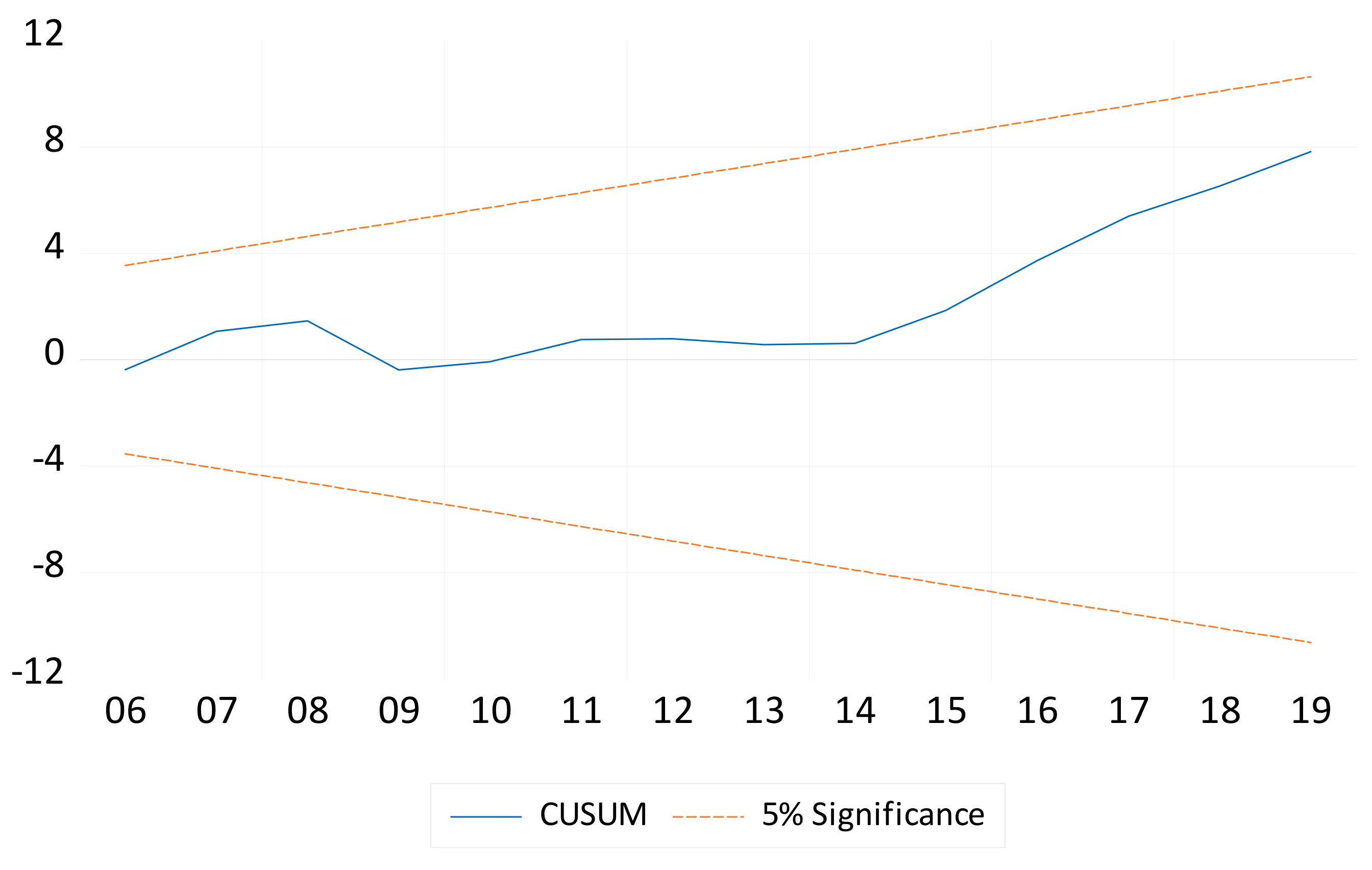
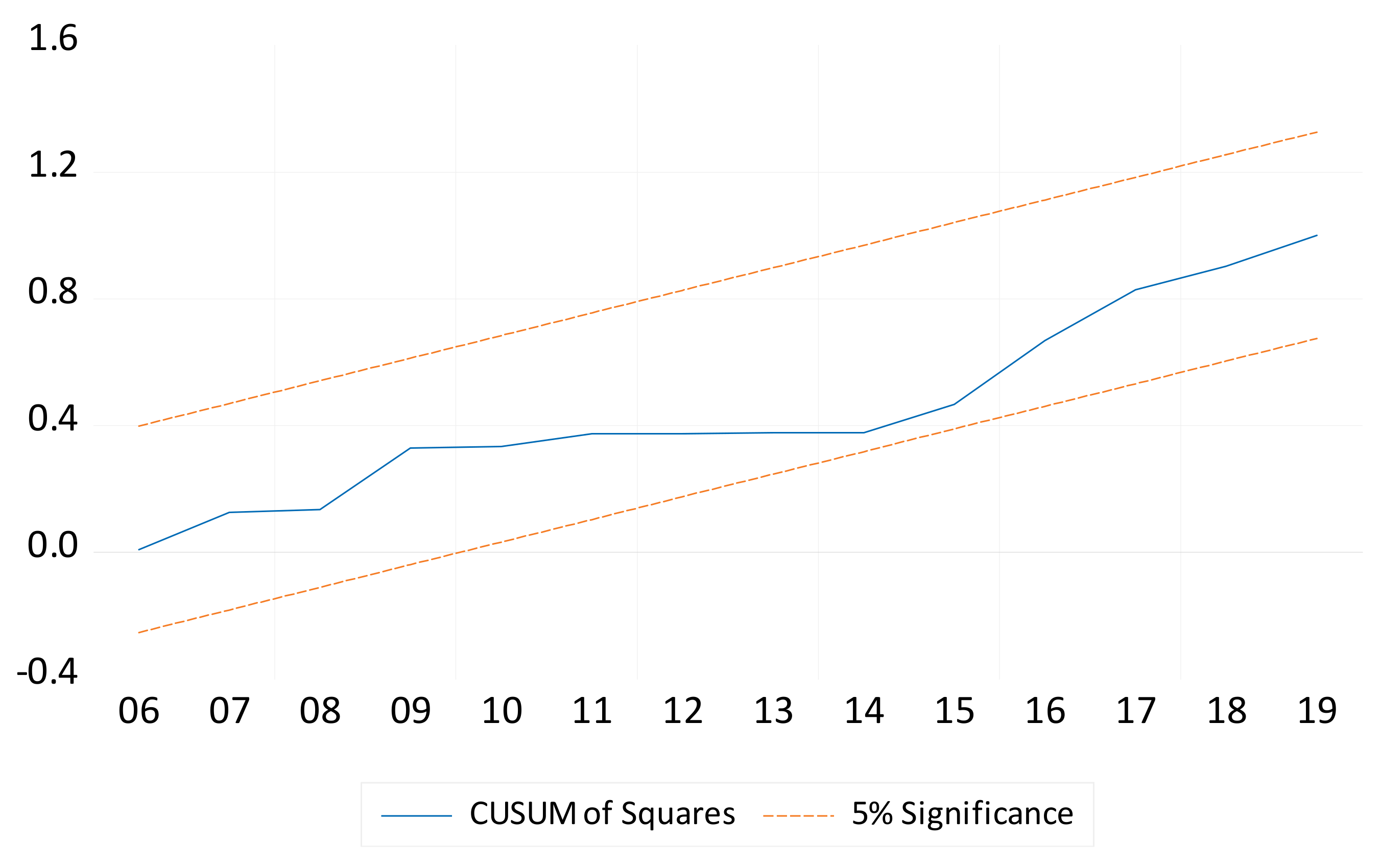
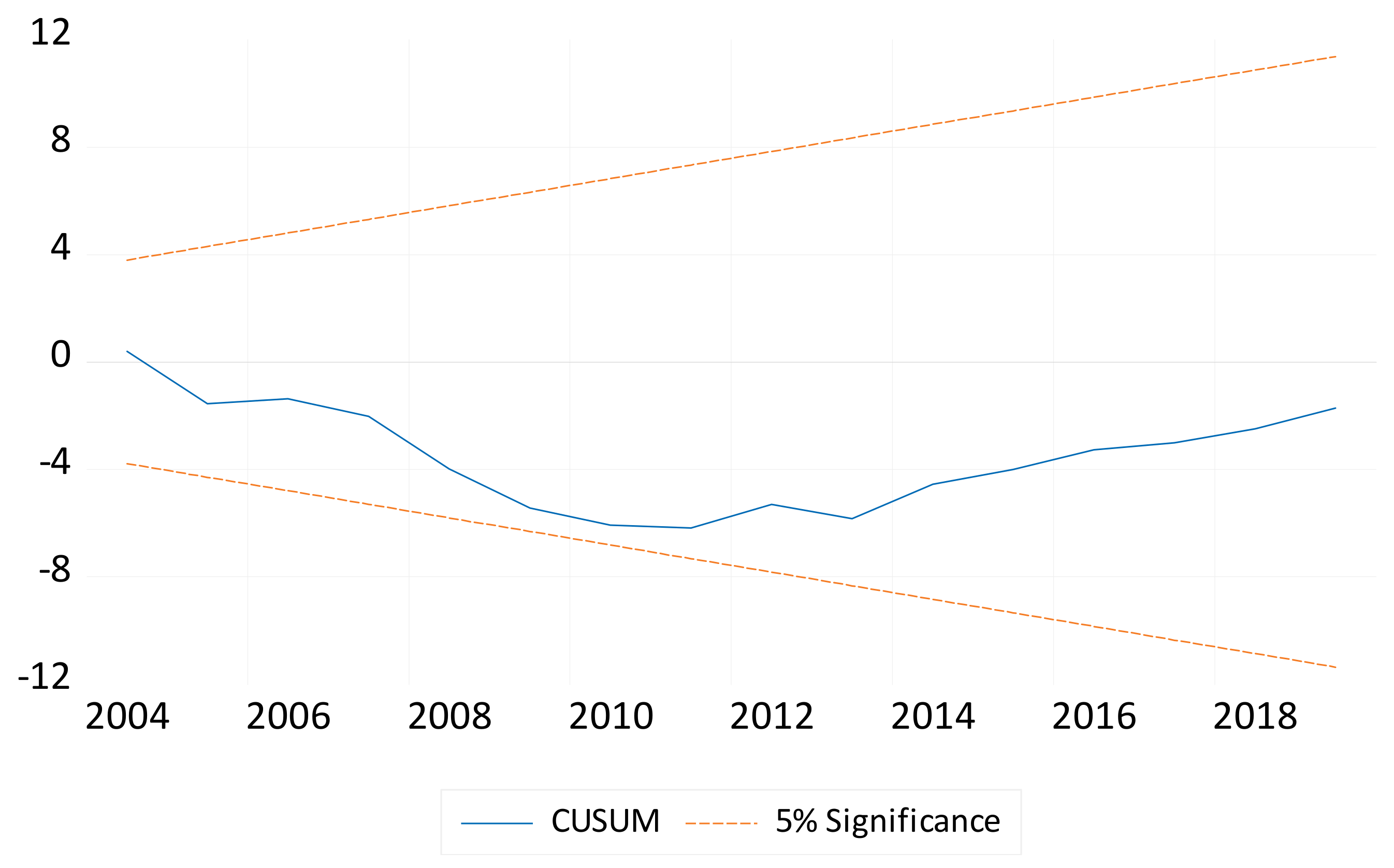
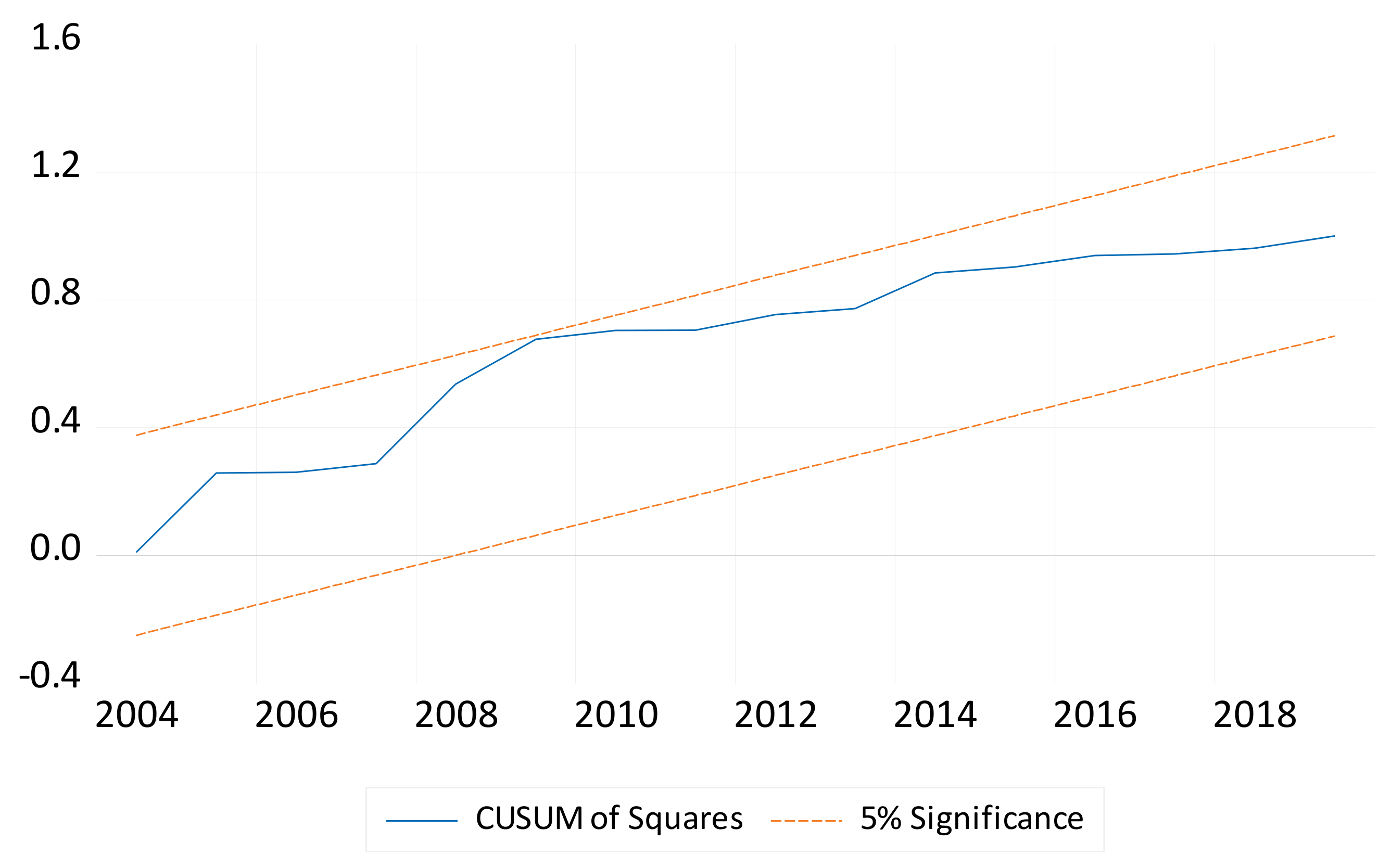
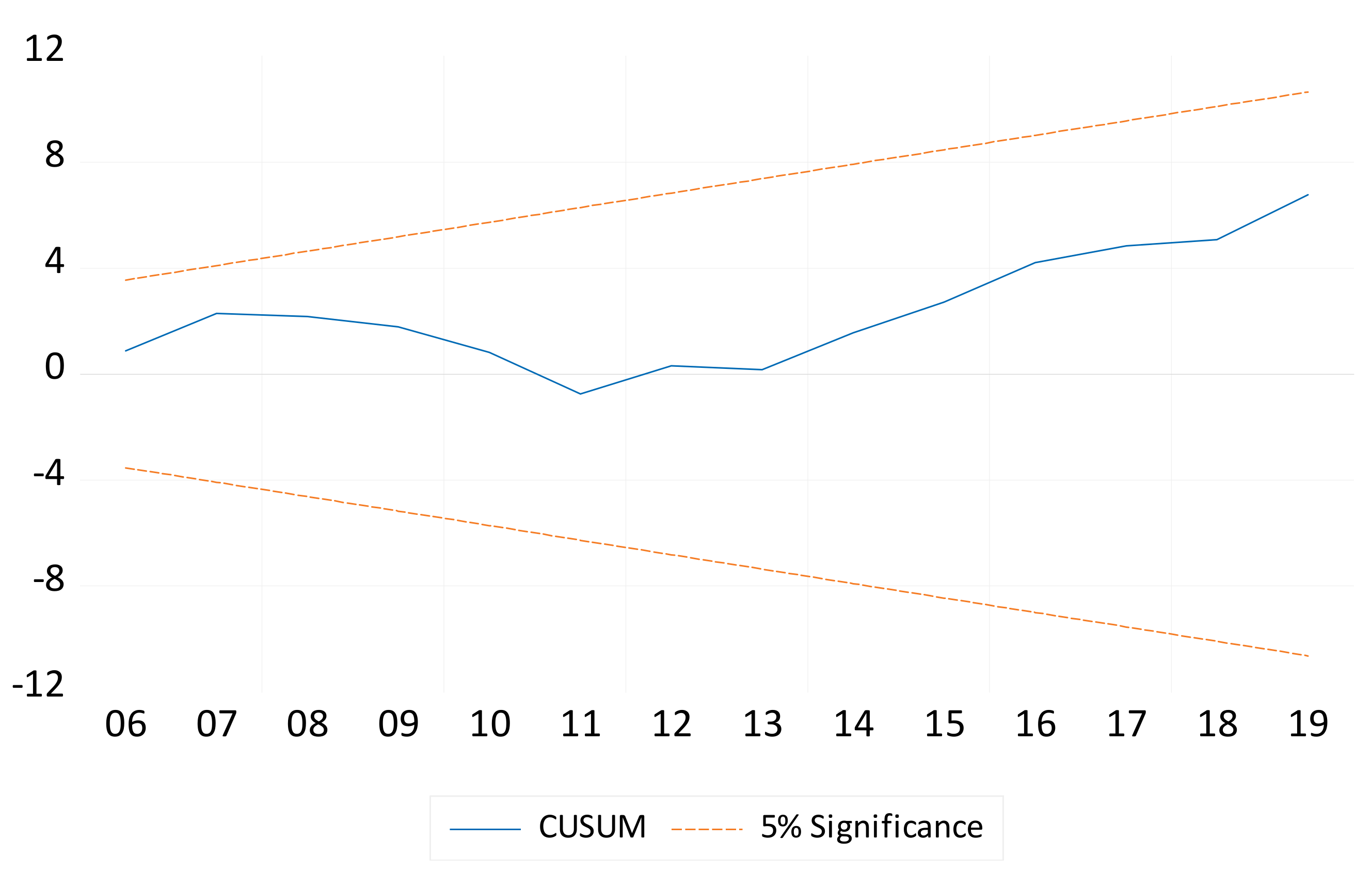
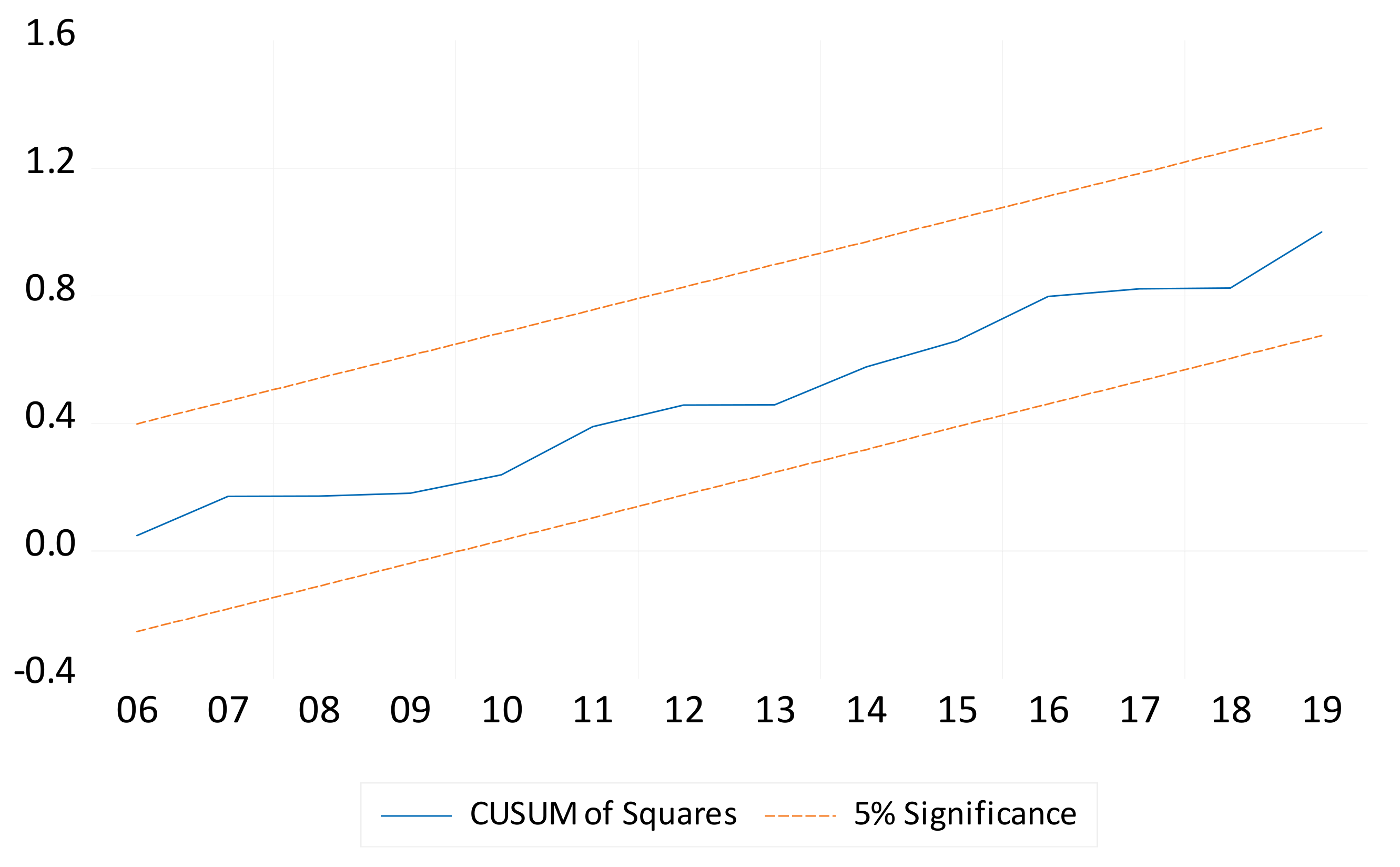
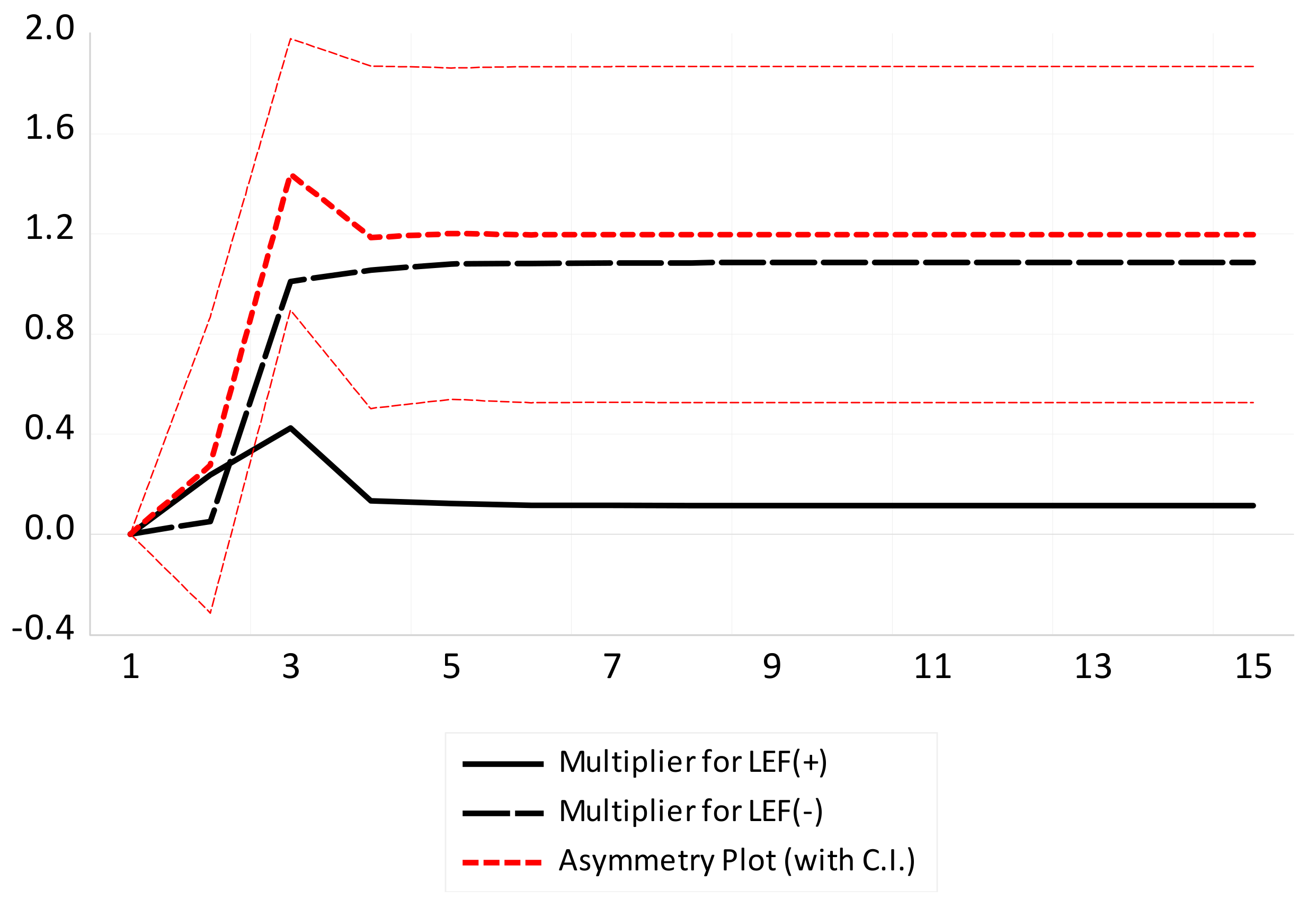
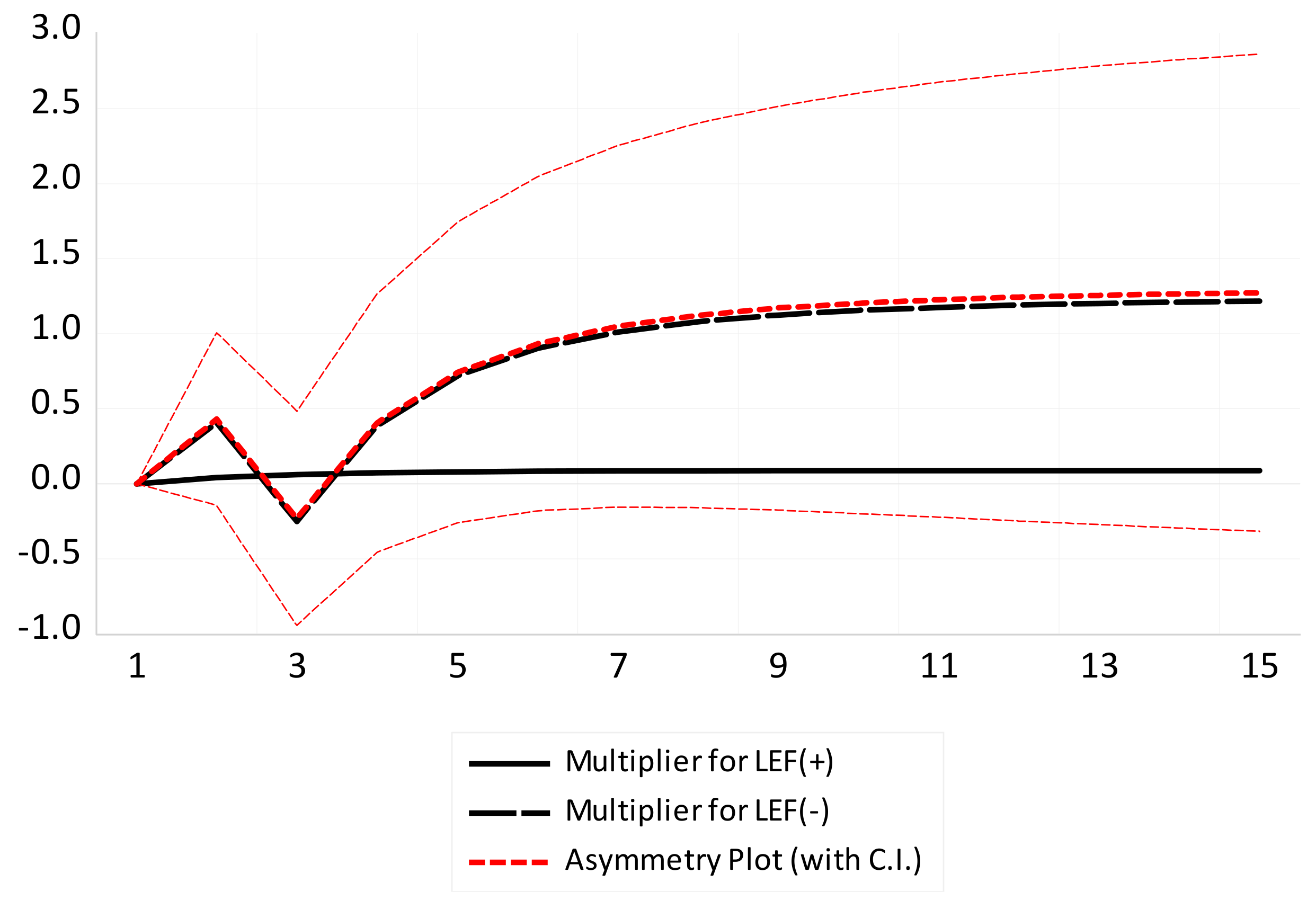
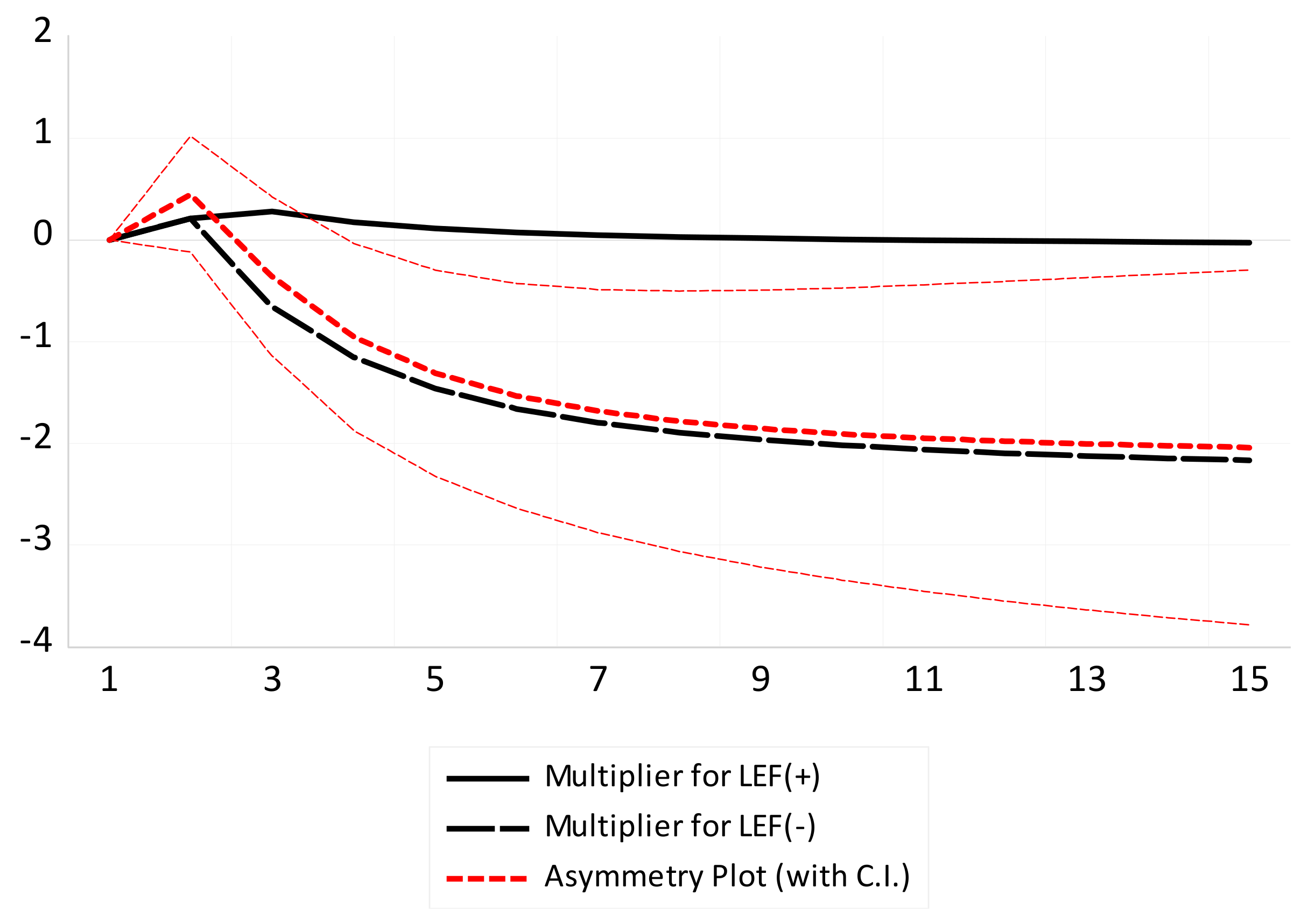
| Variable | Data Description | Source |
|---|---|---|
| LSPROD | Sectoral labor productivity—agriculture, industry, and services—is measured as value added per worker. In line with the World Bank, value added per worker is a measure of labor productivity—value added per unit of input. The value added refers to the net output of a sector, calculated by summing all outputs and subtracting intermediate inputs; the data are presented in constant 2010 U.S. dollars. | World Bank (1991–2019) |
| LEF | The employment of foreign workers (referring to non-citizens employed in Malaysia—including both skilled and unskilled labor) is measured in thousands of people. | DOSM (1991–2019) |
| LENOF | The employment of local workers lacking formal education (i.e., workers who have not attended schooling in any of the educational institutions) is quantified in thousands of people. | |
| LEPRI | The employed local workers who have attained primary education (i.e., those whose highest educational attainment is from Standard 1 to 6 or its equivalent) are expressed in thousands. |
| Mean | Median | Max. | Min. | Std. Dev. | Skewness | Kurtosis | |
|---|---|---|---|---|---|---|---|
| LPRODA | 9.572 | 9.597 | 9.876 | 9.311 | 0.182 | −0.070 | 1.699 |
| LPRODI | 10.273 | 10.325 | 10.489 | 9.900 | 0.163 | −0.853 | 2.858 |
| LPRODS | 9.629 | 9.560 | 10.021 | 9.102 | 0.239 | −0.179 | 2.300 |
| LEF | 6.988 | 6.927 | 7.716 | 5.689 | 0.581 | −0.528 | 2.586 |
| LENOF | 6.190 | 6.157 | 6.501 | 5.933 | 0.196 | 0.371 | 1.663 |
| LEPRI | 7.683 | 7.696 | 7.780 | 7.507 | 0.071 | −0.702 | 2.822 |
| ADF | PP | KPSS | ||||
|---|---|---|---|---|---|---|
| Intercept | Trend and Intercept | Intercept | Trend and Intercept | Intercept | Trend and Intercept | |
| A: Level | ||||||
| LPRODA | −0.757 (0) | −3.227 (0) *** | −0.166 (12) | −3.094 (4) | 0.662 (4) ** | 0.088 (1) |
| LPRODI | −2.114 (0) | −2.301 (0) | −2.178 (4) | −2.292 (3) | 0.637 (4) ** | 0.151 (3) ** |
| LPRODS | −1.728 (0) | −3.019 (0) | −1.624 (3) | −3.140 (3) | 0.699 (4) ** | 0.068 (2) |
| LEF | −2.159 (0) | −2.483 (0) | −2.213 (2) | −2.487 (2) | 0.650 (4) ** | 0.085 (3) |
| LENOF | −1.512 (0) | −2.026 (0) | −1.471 (1) | −1.900 (2) | 0.620 (4) ** | 0.164 (3) ** |
| LEPRI | −0.727 (0) | −1.665 (0) | −1.059 (3) | −1.922 (3) | 0.411 (4) *** | 0.067 (3) |
| B: First Difference | ||||||
| ΔLPRODA | −5.982 (0) * | −5.927 (0) * | −7.499 (11) * | −8.546 (13) * | 0.500 (27) ** | 0.500 (27) * |
| ΔLPRODI | −4.419 (0) * | −4.533 (0) * | −4.399 (2) * | −4.511 (2) * | 0.219 (0) | 0.076 (2) |
| ΔLPRODS | −4.008 (0) * | −3.940 (0) ** | −3.924 (4) * | −3.872 (3) ** | 0.143 (2) | 0.103 (2) |
| ΔLEF | −4.961 (0) * | −5.122 (0) * | −4.959 (1) * | −5.121 (1) * | 0.204 (0) | 0.097 (2) |
| ΔLENOF | −6.503 (0) * | −4.549 (1) * | −6.826 (4) * | −7.236 (5) * | 0.128 (0) | 0.078 (1) |
| ΔLEPRI | −4.943 (0) * | −5.187 (0) * | −4.943 (0) * | −5.187 (0) * | 0.154 (3) | 0.071 (3) |
| Model | F-Statistic | NARDL Order | |
|---|---|---|---|
| Model 1: LPRODA, LEF_POS, LEF_NEG, LENOF, LEPRI | 13.540 *** | (1, 2, 1, 3, 0) | |
| Model 2: LPRODI, LEF_POS, LEF_NEG, LENOF, LEPRI | 4.242 ** | (1, 0, 2, 0, 2) | |
| Model 3: LPRODS, LEF_POS, LEF_NEG, LENOF, LEPRI | 4.131 ** | (1, 2, 1, 2, 1) | |
| Critical value bounds of the F-statistic: restricted intercept and no trend (= 4) | |||
| Significance level | (0) | (1) | |
| 10% | 2.20 | 3.09 | |
| 5% | 2.56 | 3.49 | |
| 2.5% | 2.88 | 3.87 | |
| 1% | 3.29 | 4.37 | |
| Model 1 | ||||
|---|---|---|---|---|
| Variable | Coefficient | SE | t-Statistic | p-Value |
| LEF_POS | 0.112 *** | 0.036 | 3.139 | 0.007 |
| LEF_NEG | −1.039 ** | 0.376 | −2.765 | 0.015 |
| LENOF | −0.234 | 0.189 | −1.237 | 0.236 |
| LEPRI | −0.603 *** | 0.176 | −3.419 | 0.004 |
| C | 15.345 *** | 1.311 | 11.701 | 0.000 |
| Model 2 | ||||
| Variable | Coefficient | SE | t-Statistic | p-Value |
| LEF_POS | 0.090 | 0.061 | 1.466 | 0.162 |
| LEF_NEG | −1.101 | 0.726 | −1.517 | 0.149 |
| LENOF | 0.197 | 0.297 | 0.663 | 0.517 |
| LEPRI | −0.169 | 0.374 | −0.452 | 0.657 |
| C | 10.167 ** | 3.706 | 2.743 | 0.014 |
| Model 3 | ||||
| Variable | Coefficient | SE | t-Statistic | p-Value |
| LEF_POS | 0.032 | 0.125 | 0.260 | 0.799 |
| LEF_NEG | 1.957 ** | 0.734 | 2.666 | 0.019 |
| LENOF | −1.576 ** | 0.598 | −2.635 | 0.020 |
| LEPRI | −0.524 | 0.382 | −1.373 | 0.191 |
| C | 23.567 *** | 3.520 | 6.696 | 0.000 |
| Variable | Coefficient | SE | t-Statistic | p-Value |
|---|---|---|---|---|
| Model 1: LPRODA, LEF_POS, LEF_NEG, LENOF, LEPRI (1, 2, 1, 3, 0) | ||||
| 0.240 *** | 0.038 | 6.306 | 0.000 | |
| 0.303 *** | 0.041 | 7.331 | 0.000 | |
| −0.034 | 0.244 | −0.139 | 0.891 | |
| 0.023 | 0.085 | 0.275 | 0.788 | |
| −0.049 | 0.085 | −0.579 | 0.572 | |
| −0.182 ** | 0.083 | −2.180 | 0.047 | |
| −0.945 *** | 0.090 | −10.500 | 0.000 | |
| Diagnostic Tests: | ||||
| JB | 1.846 (0.397) | |||
| AR [2] | 1.438 (0.487) | |||
| ARCH [1] | 0.136 (0.712) | |||
| RESET [1] | 3.405 (0.088) | |||
| VIFs | 2.219 | |||
| Stable | ||||
| Stable | ||||
| Model 2: LPRODI, LEF_POS, LEF_NEG, LENOF, LEPRI (1, 0, 2, 0, 2) | ||||
| −0.397 | 0.257 | −1.545 | 0.142 | |
| 0.994 *** | 0.268 | 3.705 | 0.002 | |
| −0.204 | 0.148 | −1.376 | 0.188 | |
| −0.342 ** | 0.148 | −2.320 | 0.034 | |
| −0.458 *** | 0.079 | −5.779 | 0.000 | |
| Diagnostic Tests: | ||||
| JB | 0.318 (0.853) | |||
| AR [2] | 2.695 (0.260) | |||
| ARCH [1] | 0.152 (0.696) | |||
| RESET [1] | 0.002 (0.966) | |||
| VIFs | 4.398 | |||
| Stable | ||||
| Stable | ||||
| Model 3: LPRODS, LEF_POS, LEF_NEG, LENOF, LEPRI (1, 2, 1, 2, 1) | ||||
| 0.213 *** | 0.044 | 4.841 | 0.000 | |
| 0.143 *** | 0.034 | 4.184 | 0.001 | |
| −0.235 | 0.212 | −1.109 | 0.286 | |
| 0.014 | 0.077 | 0.177 | 0.862 | |
| 0.203 ** | 0.087 | 2.318 | 0.036 | |
| −0.614 *** | 0.153 | −4.012 | 0.001 | |
| −0.404 *** | 0.070 | −5.799 | 0.000 | |
| Diagnostic Tests: | ||||
| JB | 2.201 (0.333) | |||
| AR [2] | 1.570 (0.456) | |||
| ARCH [1] | 0.385 (0.535) | |||
| RESET [1] | 0.644 (0.437) | |||
| VIFs | 3.253 | |||
| Stable | ||||
| Stable | ||||
| Wald Tests | ||
|---|---|---|
| t-Statistic | F-Statistic | |
| Model 1 | ||
| Long-run | 3.530 (0.003) *** | 12.461 (0.003) *** |
| Short-run | 1.491 (0.158) | 2.223 (0.158) |
| Model 2 | ||
| Long-run | 1.695 (0.110) | 2.872 (0.110) |
| Short-run | - | - |
| Model 3 | ||
| Long-run | −2.615 (0.020) ** | 6.839 (0.020) ** |
| Short-run | 1.613 (0.129) | 2.602 (0.129) |
Disclaimer/Publisher’s Note: The statements, opinions and data contained in all publications are solely those of the individual author(s) and contributor(s) and not of MDPI and/or the editor(s). MDPI and/or the editor(s) disclaim responsibility for any injury to people or property resulting from any ideas, methods, instructions or products referred to in the content. |
© 2025 by the authors. Licensee MDPI, Basel, Switzerland. This article is an open access article distributed under the terms and conditions of the Creative Commons Attribution (CC BY) license (https://creativecommons.org/licenses/by/4.0/).
Share and Cite
Hii, N.L.; Lau, E. Asymmetric Effects of Foreign Worker Employment on Sectoral Labor Productivity: A Malaysian Perspective. Economies 2025, 13, 127. https://doi.org/10.3390/economies13050127
Hii NL, Lau E. Asymmetric Effects of Foreign Worker Employment on Sectoral Labor Productivity: A Malaysian Perspective. Economies. 2025; 13(5):127. https://doi.org/10.3390/economies13050127
Chicago/Turabian StyleHii, Neng Long, and Evan Lau. 2025. "Asymmetric Effects of Foreign Worker Employment on Sectoral Labor Productivity: A Malaysian Perspective" Economies 13, no. 5: 127. https://doi.org/10.3390/economies13050127
APA StyleHii, N. L., & Lau, E. (2025). Asymmetric Effects of Foreign Worker Employment on Sectoral Labor Productivity: A Malaysian Perspective. Economies, 13(5), 127. https://doi.org/10.3390/economies13050127






